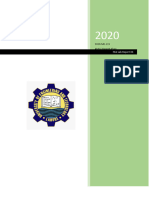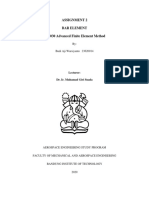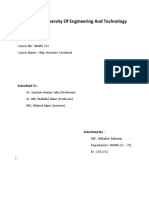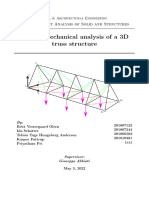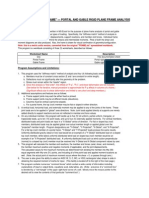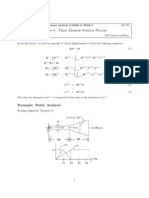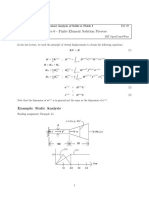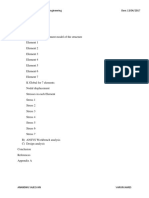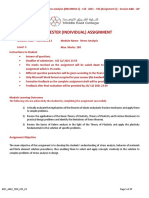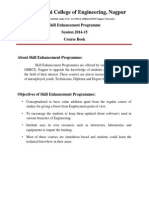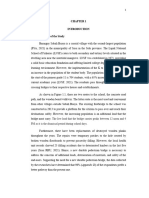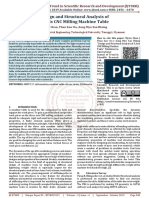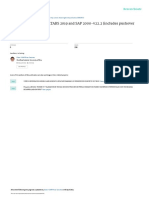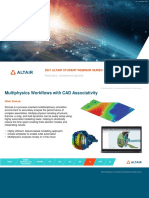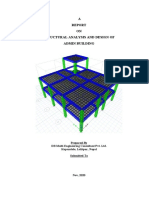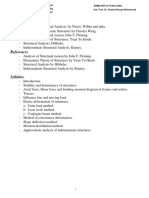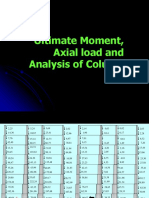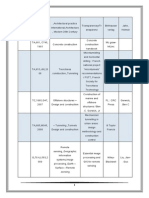TMR4190 Finite Element
Methods in Structural
Analysis
ABAQUS EXERCISE
By: RENY WATAN & XIAO CHEN
Autumn 2009
�The units which have been used to build the ABAQUS model for this project is N – cm.
Basically, when using the ABAQUS to do the analysis of a 2D frame, the following tasks will
be performed:
1. Sketching the two-dimensional (2D) geometry and creating a part representing the
frame.
2. Defining the material properties and section properties of the frame
We assigned the material under the name “Steel” with the elastic modulus of 209×103
N/mm2 = 209×105 N/cm2 and Poisson’s ratio of 0.30.
Totally, there are seven (7) types of section properties which have been used for this
jacket frame, as listed below.
Name of Diameter Thickness
Type
Section (mm) (mm)
D700-015 Pipe 700.00 15.00
D950-025 Pipe 950.00 25.00
D1100-050 Pipe 1100.00 50.00
D1330-025 Pipe 1330.00 25.00
D2100-050 Pipe 2100.00 50.00
D3100-050 Pipe 3100.00 50.00
D6100-050 Pipe 6100.00 50.00
3. Assembling the model.
TMR4190 Finite Element Methods in Structural Analysis – ABAQUS Exercise
4. Configuring the analysis procedure and output requests.
5. Applying the loads and boundary conditions to the frame.
Type Magnitude
Load Name (Horizontal
in (t) in (N)
/Vertical)
H-409 Horizontal 409.00 4012290.00
H-365 Horizontal 365.00 3580650.00
H-364 Horizontal 364.00 3570840.00
H-382 Horizontal 382.00 3747420.00
H-413 Horizontal 413.00 4051530.00
H-355 Horizontal 355.00 3482550.00
H-42 Horizontal 42.00 412020.00
Total 2330.00 22857300.00
V-2500 Vertical 2500.00 24525000.00
Total 2500.00 24525000.00
6. Meshing the frame.
The approximate global element size of 10 has been defined for this model.
2
�7. Creating a job and submitting it for analysis.
8. Viewing the results of the analysis.
For this exercise, we define the cases into four (4) cases. Case 1 is the analysis with a
complete structure, as assigned in the Exercise Problem. Case 2 and Case 3 is the analysis
with one of the braces removed. Case 4 is the analysis with two braces removed.
a. Finding the highest loaded element (element with the highest stress), calculating the
scale factor of the load to the yield stress, and finding the typical ratio between stresses
from axial forces and moments.
Case 1 (Complete 2D Structure)
TMR4190 Finite Element Methods in Structural Analysis – ABAQUS Exercise
Element with the highest highest yield scale
stress stress stress (σy ) factor
10205 1.05E+04 35000 3.32
3
�Ratio of Axial and Moment Stress
Stress at the Stress at the
Axial Moment Ratio
Top Fibre of the Bottom Fibre of
Stress Stress (axial/moment)
section the section
1.025E+04 1.052E+04 10385.00 135.00 76.9259
b. Checking the global force equilibrium
The Equilibrium state that the total forces of the structure should be equal to zero, as
written:
1. ∑ = 0
2. ∑ = 0
3. ∑ = 0
Applying equilibrium #1, we write:
=0
− + 2 × (409 + 365 + 364 + 382 + 413 + 355 + 42) = 0
= 2 × (409 + 365 + 364 + 382 + 413 + 355 + 42)
= 4660
TMR4190 Finite Element Methods in Structural Analysis – ABAQUS Exercise
= 45.7146 × 10
Applying equilibrium #2, we write:
=0
+ − 2 × (2500) = 0
+ = 5000 = 49.050 × 10 ……….( )
Applying equilibrium #2, we write:
=0
−( × 75) + 2
× (409 × 28 + 365 × 56 + 364 × 84 + 382 × 112 + 413 × 140 + 355
× 168 + 42 × 184.5) + (2500 × 24.25) + (2500 × 50.75) . = 0
× 75 = 648422 .
= 8645.6266 = 84813597.6
4
�Substitute = 84813597.6 N to equation (a), will result
= −3645.62667 = −35.7636 × 10
From the ABAQUS, the reaction forces at the constraints (boundary conditions) are
Part
Node ID Elements RF, RF1
Instance
PART-1-1 16 Elem-1 -4.57146E+07
PART-1-1 24 Elem-1 0
Part
Node ID Elements RF, RF2
Instance
PART-1-1 24 Elem-1 8.48136E+07
PART-1-1 16 Elem-1 -3.57636E+07
c. Control axial load in the 5th floor of the structure.
TMR4190 Finite Element Methods in Structural Analysis – ABAQUS Exercise
5
� . .
tan = tan =
. .
To control the axial load in the 5th floor of the structure, we could substitute the SF1 into the
equilibrium equation as expressed below:
=0
1 × sin + 1 × sin + 1 × sin + 1 × sin
= (2 × 2500) × 9.81 × 1000
4.89862 × 10 ≈ 4.9050 × 10
=0
− 1 × cos − 1 × cos + 1 × cos + 1 × cos + 2 × (413 + 355 + 42)
× 9.81 × 1000 = 0
1 × cos + 1 × cos − 1 × cos − 1 × cos
= 2 × (413 + 355 + 42) × 9.81 × 1000
TMR4190 Finite Element Methods in Structural Analysis – ABAQUS Exercise
1.5103 × 10 ≈ 1.5892 × 10
We can conclude that the result from Abaqus is nearly coinciding with the hand calculation
result.
6
� d. The other cases
Case 2
TMR4190 Finite Element Methods in Structural Analysis – ABAQUS Exercise
Element with the highest highest yield scale
stress stress stress (σy ) factor
988 1.648E+04 35000 2.124
7
�Case 3
TMR4190 Finite Element Methods in Structural Analysis – ABAQUS Exercise
Element with the highest highest yield scale
stress stress stress (σy ) factor
1103 2.514E+04 35000 1.392
8
�Case 4
Element with the highest highest yield stress scale
TMR4190 Finite Element Methods in Structural Analysis – ABAQUS Exercise
stress stress (σy ) factor
5356 3.126E+04 35000 1.120
The strength reduction is
% of
Case
reduction
case 2 36.10%
case 3 58.11%
case 4 66.31%
The relation between the stress from the axial forces and moments becomes
Stress at the Stress at the
Axial Moment Ratio
Case Top Fibre of the Bottom Fibre of
Stress Stress (axial/moment)
section the section
Case 2 1.642E+04 1.646E+04 16440.00 20.00 822.0000
Case 3 2.613E+04 2.179E+04 23960.00 -2170.00 -11.0415
Case 4 3.159E+04 2.605E+04 28820.00 -2770.00 -10.4043
From the table above it can be shown that the axial stresses dominate the stress of the
structure.
